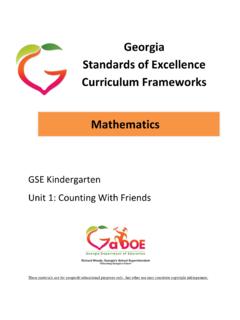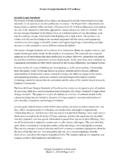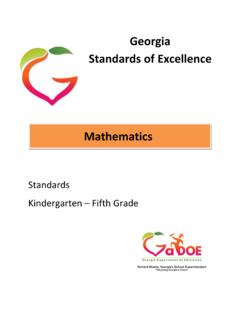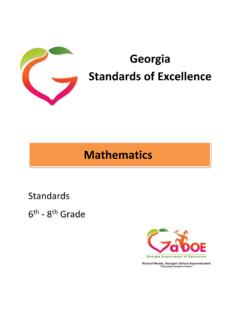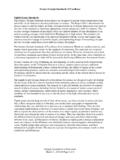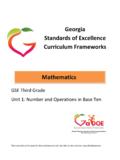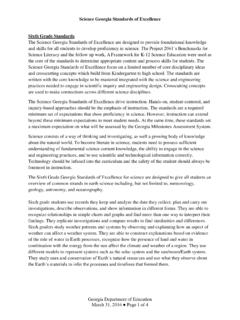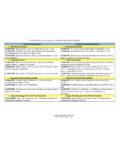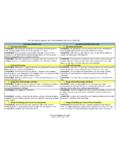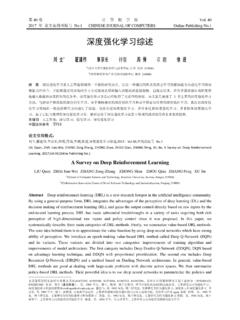Transcription of Georgia Standards of Excellence Curriculum Map Mathematics
1 Georgia Standards of Excellence Curriculum Map GSE Grade 6 These materials are for nonprofit educational purposes only. Any other use may constitute copyright infringement. Mathematics Georgia Department of Education Richard Woods, State School Superintendent July 2016 Page 2 of 7 All Rights Reserved GSE Grade 6 Curriculum Map 1st Semester 2nd Semester Unit 1 (4 5 weeks) Unit 2 (3 4 weeks) Unit 3 (4 5 weeks) Unit 4 (4 5 weeks) Unit 5 (4 5 weeks) Unit 6 (4 5 weeks) Unit 7 (3 4 weeks) Unit 8 (3 4 weeks) Number S ystem Fluency Rat e, Ratio and Proportional Reasoning U sing Equival ent Fractions Expressions One-Step Equations and Inequalities Area and Vol ume Stat istics Rational Explorations: Numbers and their Opposites Show What We Know (equations) ALL These units were written to build upon concepts fro m prior units, so later units contain tasks that depend upon the concepts addressed in earlier units.
2 All units will include the Mathematical Practices and indicate skills to maintain. NOTE: Mathematical Standards are int erwoven and should be addressed throughout the year in as many di fferent units and tasks as possible in or der to stress the natural connections that exist among mathematical topics. Grades 6-8 Key: NS = The Number System RP = Ratios and Proportional Relationships EE = Expressions and Equations G = Geometry SP = Statistics and Probabi lity. Georgia Department of Education Richard Woods, State School Superintendent July 2016 Page 3 of 7 All Rights Reserved Georgia Standards of Excellence Grade 6 Mathematics Curriculum Map Rationale Unit 1: Extending students experience with whole number computation in elementary grades, division of fractions by fractions and all four operations on decimals are a focus in the first unit. Tasks utilize hands-on activities as a means to building understanding, rather than rote memorization of algorithms.
3 Students also find common factors and multiples and deepen and extend their understanding of the distributive property to work with fractions. Unit 2: Students work extensively with ratios and rational thinking through tasks and activities that generate deep understanding. The unit explores unit rate and comparative size , while focusing on real-world problems. Unit 3: Students begin a more formal study of algebra as they move from arithmetic experiences to algebraic representations. Students learn to translate verbal phrases and numeric situations into algebraic expressions, understand like-terms, and work with exponential notation. Unit 4: Extending the study of algebra, students reason about and solve one-step equations and inequalities. Often two quantities are not balanced or equal, and this unit introduces them to inequalities and how numbers compare, including work with number lines.
4 Unit 5: Students extend their work with area and volume from simple figures in elementary school to more complex figures, including those with sides of fractional lengths. Complex figures will be composed and decomposed into familiar triangles and rectangles in order to compute their areas. Nets of solid figures allow students to calculate the surface area of three-dimensional figures. Unit 6: Students are introduced to the study of statistics, first by learning what constitutes a statistical question, then by collecting data through such questions and data sorting and analyzing. Statistical measures allow for the description of data through single-number summaries of center and distribution, and students explore and become familiar with what data looks like and find meaning in their samples. Unit 7: Up to this point, students have only encountered numbers with values greater than or equal to zero (Natural Numbers, Counting Numbers, and Whole Numbers).
5 Unit 7 introduces students conceptually to circumstances best described with negative numbers, numbers with a value less than zero- the set of Integers. Integer operations are taught in seventh grade, but by introducing students to integers in sixth grade, they have the opportunity to explore situations appropriately represented by negative numbers, and graph points in all four quadrants of the coordinate plane. Using a number line, students learn about numbers and their opposites (additive inverses), and absolute value (distance from zero). This unit is intentionally placed at the end of sixth grade, as it is not an expectation of the Standards for sixth grade students to do any operations with integers. Instead, this unit is intended as an introduction. It leads directly into the first seventh grade unit, Operations with Rational Numbers. Georgia Department of Education Richard Woods, State School Superintendent July 2016 Page 4 of 7 All Rights Reserved GSE Grade 6 Expanded Curriculum Map 1st Semester Standards for Mathematical Practice 1 Make sense of problems and persevere in solving them.
6 2 Reason abstr actly and quantitatively. 3 Constr uct viable arg uments and critique the reasoning of others. 4 Model with Mathematics . 5 Use appropriate tools strategically. 6 Atte nd to precision. 7 Look for and make use of str ucture . 8 Look for and express regularity in repeated reasoning. 1st Semester Unit 1 Unit 2 Unit 3 Unit 4 Number System Fluency Rate, Ratio and Proportional Reasoning Using Equivalent Fti Expressions One-Step Equations and Inequalities Apply and extend previous understandings of multiplicati on and divisi on to divide fractions by fractions. Interpret and compute quotients of fractions, and solve word problems involving division of fractions by fractions, including reasoning strategies such as using visual fraction models and equations to represent the problem.
7 For example: How much chocolate will each person get if 3 people share 1/2 lb of chocolate equally? How many 3/4-cup servings are in 2/3 of a cup of yogurt? How wide is a rectangular strip of land with length 3/4 mi and area 1/2 square mi? Create a story context for (2/3) (3/4)and use a visual fraction model to show the quotient; Three pizzas are cut so each person at the table receives pizza. How many people are at the table? Use the relationship between multiplication and division to explain that (2/3) (3/4)= 8/9 becaus3 3/4 of 8/9 is2/3. (In general, (a/b) (c/d) =ad/bc.) Compute fluently with multi -d igit numbers and find common factors and multi ples. Fluently divide multi-digit numbers using the standard algori thm. Fluently add, subtract, multiply, and divide multi digit decimals using the standard algorithm for each operation. Find the common multiples of two whole numbers less than or equal to 12 and h hl b l Understand ratio concepts and use ratio reasoning to solve problems.
8 Understand the concept of a ratio and use ratio language to describe a ratio relationship between two quantities. For example, The ratio of wings to beaks in the bird house at the zoo was 2:1, because for every 2 wings there was 1 beak. For every vote candidate A received, candidate C received nearly three votes. Understand the concept of a unit rate a / b associated with a ratio a: b with b 0 (b not equal to zero), and use rate language in the context of a ratio relationship. For example, "This recipe has a ratio of 3 cups of flour to 4 cups of sugar, so there is 3/4 cup of flour for each cup of sugar." "We paid $75 for 15 hamburgers, which is a rate of $5 per hamburger." Use ratio and rate reasoning to solve real-world and mathematical problems utilizing strategies such as tables of equivalent ratios, tape diagrams (bar models), double number line diagrams, and/or equations. Make tables of equivalent ratios relating quantities with whole-number measurements, find missing values in the tables, and plot the pairs of values on the coordinate plane.
9 Use tables to compare ratios. Solve unit rate problems including those involving unit pricing and constant speed. For example, If it took 7 hours to mow 4 lawns, then at that rate, how many Apply and extend previous understandings of arithmetic to algebraic expressions. Write and evaluate numerical expre ssions involving whole-n umber exponents. Writ e, read, and evaluate expre ssions in which letters stand for numbers. Write expre ssions that record operations with numbers and with lette rs standing for numbers. Id entify parts of an expre ssion using mathematical terms (sum, term, pro duct, factor, quotient, coefficient); view one or more parts of an expre ssion as a single entity. Evaluate expre ssions at specific values for their variables. In clude expre ssions that arise fro m formulas in real-world pro blems. Perf orm arit hmetic opera tions, including those involving whole-number exponents, in the conventional order when there are no pare ntheses to specify a parti cular ord er (Order of Opera tions).
10 Apply the properti es of opera tions to generate equivalent expre ssions. Id entify when two expre ssions are equivalent ( , when the two expre ssions name the same number regard less of which value is substituted into them). Find the common multiples of two whole numbers less than or equal to 12 and the common factors of two whole numbers less than or equal to 100. a. Find the greatest common factor of 2 whole numbers and use the distributive property to express a sum of two whole numbers 1-100 with a common factor Reason about and solve one-variable equati ons and inequalities. Underst and solving an equation or inequality as a pro cess of answering a questi on: which values fro m a specified set, if any, make the equation or inequality true? Use substitution to determine whether a given number in a specified set makes an equation or inequality true. Use variables to repre sent numbers and write expre ssions when solving a real-world or mathematical pro blem; underst and that a variable can repre sent an unknown number, or, depending on the purpose at hand, any number in a specified set.
